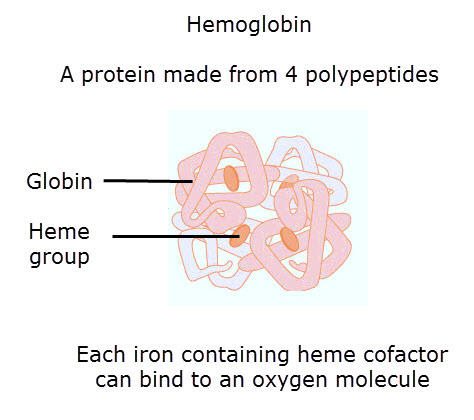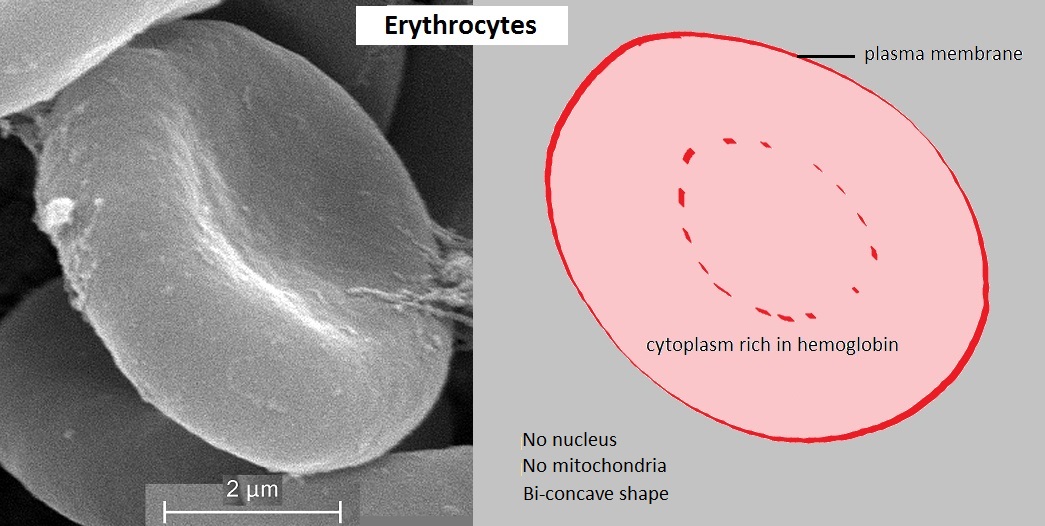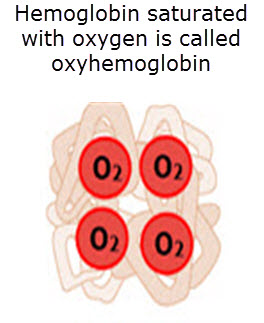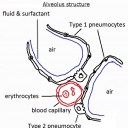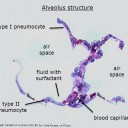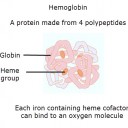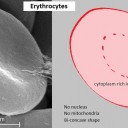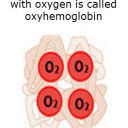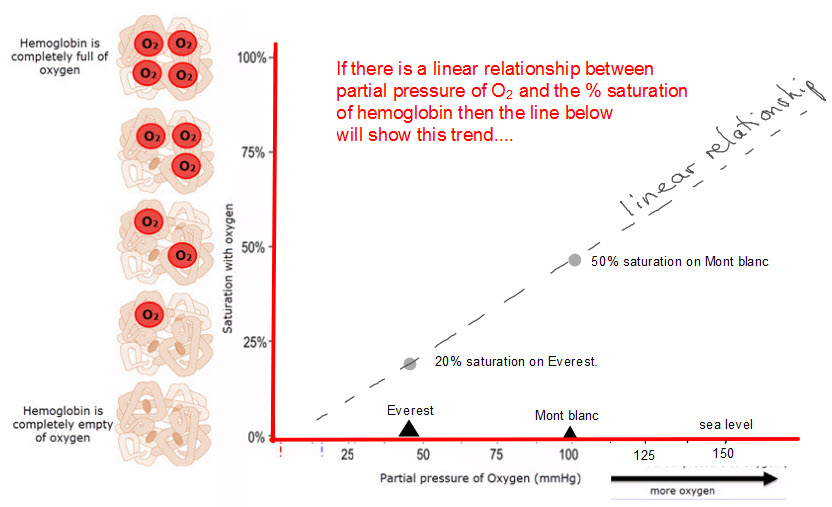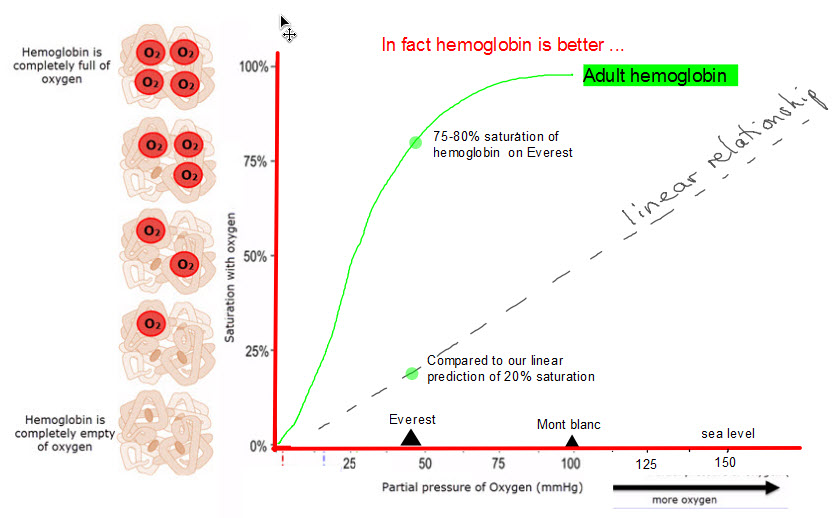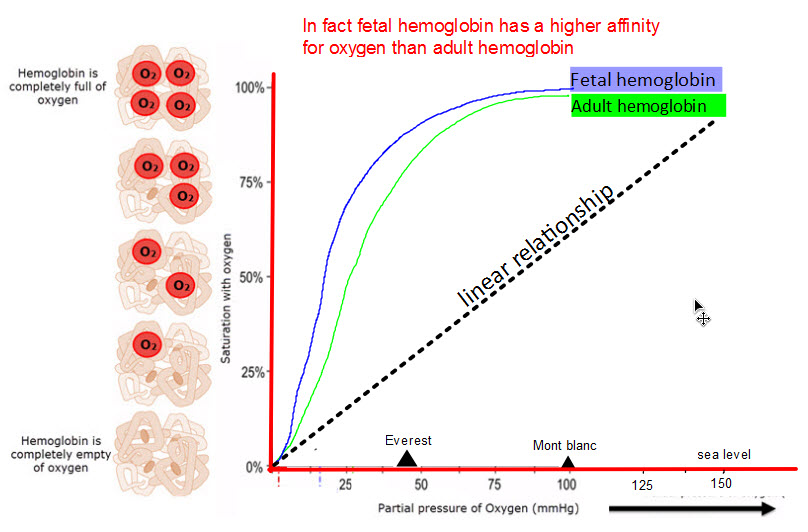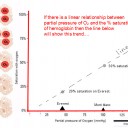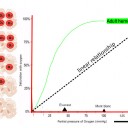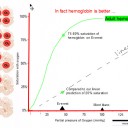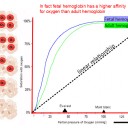Oxygen dissociation curves
 Oxygen dissociation curves show the affinity of hemoglobin for oxygen but they are not easy to understand. This activity provides resources for students to become familiar with partial pressures of oxygen and carbon dioxide as well as understanding the role of hemoglobin in the blood and the alveoli in the lungs. A group of Indian mountaineers begin the activity. Students also consider the effects of high altitude on the blood.
Oxygen dissociation curves show the affinity of hemoglobin for oxygen but they are not easy to understand. This activity provides resources for students to become familiar with partial pressures of oxygen and carbon dioxide as well as understanding the role of hemoglobin in the blood and the alveoli in the lungs. A group of Indian mountaineers begin the activity. Students also consider the effects of high altitude on the blood.
Lesson Description
 Guiding Questions
Guiding Questions
- What does "partial pressure" of a gas represent?
- If the hemoglobin in the lungs attaches to oxygen molecules, how do the muscles take this oxygen away from the hemoglobin?
- A fetus must also take the oxygen from the mother's hemoglobin, how can it do that?
Activity 1 - Why do climbers need oxygen on Everest?
Watch the short video showing an Indian climber on the summit of Everest then answer the questions which follow.
![]() Everest summit with Anand Kumar
Everest summit with Anand Kumar
Questions
1. The black masks are providing the climbers in red and yellow with oxygen. Why do they need extra oxygen on Everest?
...............................................................................................................................................................
2. Why is the Nepalese Sherpa, wearing blue, not using an oxygen mask?
...............................................................................................................................................................
3. What is different in the body of someone who lives and works at high altitude, like the Sherpas?
...............................................................................................................................................................
Click the eye icon to see some suggested answers.
Questions - model answers
1. The black masks are providing the climbers in red and yellow with oxygen. Why do they need extra oxygen on Everest?
At 8848m above sea level the air pressure is lower.
This means that the lungs contain fewer air molecules per breath
Red blood cells cannot pick up as much oxygen at this altitude and so climbers use extra oxygen from canisters.
2. Why is the Nepalese Sherpa, wearing blue, not using an oxygen mask?
Sherpas have become acclimatised to the low pressure air, and often need little or no oxygen while accompanying climbers.
3. What is different in the body of someone who lives and works at high altitude, like the Sherpas?
The body makes more red blood cells, and these extra cells increase the uptake of oxygen from the air in the lungs after acclimatisation at altitude. For this reason many athletes do high altitude training before big events.
Activity 2 - What is special about red blood cells?
Investigate the structure and function of red blood cells beginning in the lungs.
Record your findings on ![]() this worksheet shown below.
this worksheet shown below.
Use a diagram of the lungs (revision) for identification of pneumocytes, capillary endothelium cells and blood cells in light micrographs and electron micrographs of lung tissue. Understand that erythrocytes are an exception to cell theory because they have no nucleus (and no mitochondria) hemoglobin is a protein with 4° structure. The importance of iron and the way each globin carries two oxygen molecules.
Activity 3 - How does hemoglobin trap oxygen?
Oxygen dissociation curves are graphs that describe the affinity of hemoglobin for oxygen.
Use the diagrams below to explore how the partial pressure of oxygen affects the % saturation of hemoglobin.
With the help of a text book, answer the questions below.
 Questions
Questions
1. Myoglobin is found in muscle cells and hemoglobin in blood. Explain how the fact that myoglobin is always more saturated than hemoglobin (at the same partial pressure of oxygen) aids the transport of oxygen into muscles?
...............................................................................
...............................................................................
2. Hemoglobin F is found in fetal blood and hemoglobin A in adult blood. Explain how the fact that hemoglobin F is always more saturated than hemoglobin A (at the same partial pressure of oxygen) aids the transport of oxygen from mother to baby?
................................................................................
................................................................................
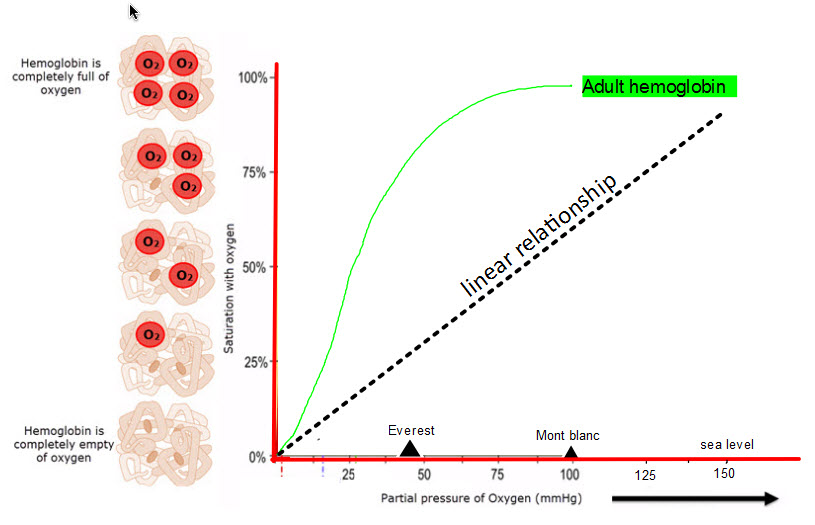 3. What is the difference in the saturation of the blood on Everest, Mont Blanc and at sea level?
3. What is the difference in the saturation of the blood on Everest, Mont Blanc and at sea level?
................................................................................
................................................................................
4. Why do you think the blood of someone who lives and works at high altitude, like the Sherpas would contain more erythrocytes per litre than someone who lives at sea level?
................................................................................
................................................................................
5. Training camps for athletes are frequently located at high altitude to increase the hemoglobin content of the blood.
Why does the body produce more hemoglobin when at altitude?
................................................................................
................................................................................
Click the eye icon to see some suggested answers.
Questions - model answers
1. Myoglobin is found in muscle cells and hemoglobin in blood. Explain how the fact that myoglobin is always more saturated than hemoglobin (at the same partial pressure of oxygen) aids the transport of oxygen into muscles?Myoglobin has a higher affinity for oxygen than hemoglobin. At the same partial pressure of oxygen myoglobin will have more of the oxygen. This allows oxygen to diffuse out of blood capillaries and bind to myoglobin in muscle cells.
2. Hemoglobin F is found in fetal blood and hemoglobin A in adult blood. Explain how the fact that hemoglobin F is always more saturated than hemoglobin A (at the same partial pressure of oxygen) aids the transport of oxygen from mother to baby?
In the placenta the mothers blood and the fetus' blood are brought close together. The hemoglobin F has a higher affinity for the oxygen and so oxygen passes into the fetus' blood.
3. What is the difference in the saturation of the blood on Everest, Mont Blanc and at sea level?
On Everest the hemoglobin will be 80% saturated, on Mont blanc close to 100% saturated, but below 100% and at sea level 100% saturated.
4. Why do you think the blood of someone who lives and works at high altitude, like the Sherpas would contain more erythrocytes per litre than someone who lives at sea level?
In lower partial pressures of oxygen the body makes more red blood cells to compensate for the increased difficulty in getting oxygen from the air.
5. Training camps for athletes are frequently located at high altitude to increase the hemoglobin content of the blood.
Why does the body produce more hemoglobin when at altitude?
If an athlete trains at high altitude the body will produce more hemoglobin and more erythrocytes in order to get as much oxygen to the muscles as possible. This is an advantage when the athlete returns to sea level as the raised levels of hemoglobin allow more oxygen to be carried to the muscles.
Teachers' notes
This lesson covers the following points from the guide.
- Oxygen dissociation curves show the affinity of hemoglobin for oxygen.
- Application: Consequences of high altitude for gas exchange
- Training camps for athletes are frequently located at high altitude to increase the hemoglobin content of the blood. This puts the athlete at an advantage when they return to lower ground for competition.
These points haven't been covered and it would be good to add something to cover them.
- Application: Causes and treatments of emphysema.

 IB Docs (2) Team
IB Docs (2) Team



